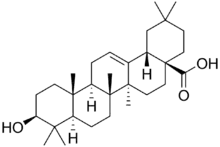Oleanolic acid
Oleanolic acid or oleanic acid is a naturally occurring pentacyclic triterpenoid related to betulinic acid. It is widely distributed in food and plants where it exists as a free acid or as an aglycone of triterpenoid saponins.[2]
 | |
| Names | |
|---|---|
| IUPAC name
(4aS,6aR,6aS,6bR,8aR,10S,12aR,14bS)-10-hydroxy-2,2,6a,6b,9,9,12a-heptamethyl-1,3,4,5,6,6a,7,8,8a,10,11,12,13,14b-tetradecahydropicene-4a-carboxylic acid | |
| Other names
Oleanic acid | |
| Identifiers | |
3D model (JSmol) |
|
| ChEBI | |
| ChEMBL | |
| ChemSpider | |
| ECHA InfoCard | 100.007.347 |
| EC Number |
|
PubChem CID |
|
| UNII | |
CompTox Dashboard (EPA) |
|
| |
| |
| Properties | |
| C30H48O3 | |
| Molar mass | 456.711 g·mol−1 |
| Appearance | White |
| Melting point | > 300 °C (572 °F; 573 K) |
Except where otherwise noted, data are given for materials in their standard state (at 25 °C [77 °F], 100 kPa). | |
| Infobox references | |
Natural occurrence
Oleanolic acid can be found in olive oil, Phytolacca americana (American pokeweed), and Syzygium spp, garlic, etc. It was first studied and isolated from several plants, including Olea europaea[3] (leaves, fruit), Rosa woodsii (leaves), Prosopis glandulosa (leaves and twigs), Phoradendron juniperinum (whole plant), Syzygium claviflorum (leaves), Hyptis capitata (whole plant), Mirabilis jalapa[4] and Ternstroemia gymnanthera (aerial part). Other Syzygium species including java apple (Syzygium samarangense) and rose apples contain it.
Pharmacological research
Oleanolic acid is relatively non-toxic, hepatoprotective, and exhibits antitumor and antiviral properties.[5]
Oleanolic acid was found to exhibit weak anti-HIV[6] and weak anti-HCV activities in vitro, but more potent synthetic analogs are being investigated as potential drugs.[7]
An extremely potent synthetic triterpenoid analog of oleanolic acid was found in 2005, that is a powerful inhibitor of cellular inflammatory processes. They work by the induction by IFN-γ of inducible nitric oxide synthase (iNOS) and of cyclooxygenase 2 in mouse macrophages. They are extremely potent inducers of the phase 2 response (e.g., elevation of NADH-quinone oxidoreductase and heme oxygenase 1), which is a major protector of cells against oxidative and electrophile stress.[8]
A 2002 study in Wistar rats found that oleanolic acid reduced sperm quality and motility, causing infertility. After withdrawing exposure, male rats regained fertility and successfully impregnated female rats.[9]
See also
- Ursolic acid
- Betulinic acid
- Moronic acid
- Momordin (saponin), a glycoside of oleanolic acid
- List of phytochemicals in food
References
- "Oleanolic acid". Sigma-Aldrich. Merck. Retrieved November 29, 2018.
- Pollier J, Goossens A (May 2012). "Oleanolic acid". Phytochemistry. 77: 10–15. doi:10.1016/j.phytochem.2011.12.022. PMID 22377690.
- "Oleanolic acid (HMDB0002364)". HMDB. Canadian Institutes of Health Research. Retrieved November 29, 2018.
- Constituents of Mirabilis jalapa. Siddiqui S., Siddiqui B.S., Adil Q. and Begum S., Fitoterapia, 1990, Volume 61, No. 5, page 471 (abstract Archived 2014-01-04 at the Wayback Machine)
- Liu J (December 1995). "Pharmacology of oleanolic acid and ursolic acid". J Ethnopharmacol. 49 (2): 57–68. doi:10.1016/0378-8741(95)90032-2. PMID 8847885.
- Mengoni F, Lichtner M, Battinelli L, Marzi M, Mastroianni CM, Vullo V, Mazzanti G (February 2002). "In vitro anti-HIV activity of oleanolic acid on infected human mononuclear cells". Planta Med. 68 (2): 111–4. doi:10.1055/s-2002-20256. PMID 11859458.
- Yu F, Wang Q, Zhang Z, Peng Y, Qiu Y, Shi Y, et al. (June 2013). "Development of oleanane-type triterpenes as a new class of HCV entry inhibitors". J. Med. Chem. 56 (11): 4300–19. doi:10.1021/jm301910a. PMID 23662817.
- Dinkova-Kostova AT, Liby KT, Stephenson KK, Holtzclaw WD, Gao X, Suh N, et al. (March 2005). "Extremely potent triterpenoid inducers of the phase 2 response: correlations of protection against oxidant and inflammatory stress". Proc. Natl. Acad. Sci. U.S.A. 102 (12): 4584–9. doi:10.1073/pnas.0500815102. PMC 555528. PMID 15767573.
- Mdhluli MC, van der Horst G (October 2002). "The effect of oleanolic acid on sperm motion characteristics and fertility of male Wistar rats". Lab Anim. 36 (4): 432–7. doi:10.1258/002367702320389107. PMID 12396287.